Study on the Tribological Behavior of Laser Surface Texturing on Silicon Nitride Ceramic Under Water Lubrication
Abstract
:1. Introduction
2. Materials and Methods
2.1. Materials
2.2. LST of Different Patterns on Si3N4 Ceramic
2.3. Friction Test
2.4. Measurement and Characterization
3. Results and Discussion
3.1. Surface Wettability of the Si3N4 Ceramic Before and After LST
3.2. COF of the Si3N4 Ceramic with Different Textured Patterns
3.3. Wear Morphology of the Si3N4 Ceramic with Different Textured Patterns
3.4. Wear Rate of the Si3N4 Ceramic with Different Textured Patterns
3.5. Friction and Wear Mechanisms of the Si3N4 Ceramic with Different Textured Patterns
4. Conclusions
- Surface wettability was significantly affected by textured patterns. The original surface of the Si3N4 ceramic was hydrophobic. However, the surface wettability was effectively improved by introducing triangular patterns. The surface of the Si3N4 ceramic changed from hydrophobic to hydrophilic. TP exhibited better surface wettability. In contrast, the surface containing hexagonal patterns was still hydrophobic, and the CA of HP was close to UP.
- The COF of UP continued to increase with the increase in reciprocating frequency. The COF of TP was more stable compared to that of UP and HP. The factors affecting COF were textured patterns and surface wettability. At lower reciprocating frequencies, the surface structure had a significant impact on the COF. As the reciprocating frequency increased, the influence of surface wettability on the COF increased. In this condition, hydrophilic surfaces exhibited better lubrication, so the COF was lower.
- The surface of UP suffered the most severe damage as a result of the lack of textured patterns and poor surface wettability. Finer debris can be observed on the surface of TP and HP. This was mainly due to the capturing and cutting effects of textured patterns. The wear rate of the WU was higher than that of the WT and WH. The difference decreased with the increase in reciprocating frequency. The WH was smaller than the WT, which could be attributed to the more symmetrical structure and more uniform distribution of force on the surface of HP.
- Lubricant could be stored in textured patterns. Better surface wettability meant that the lubricant more easily adhered to the surface of samples during reciprocating friction. Thus, the COF of the Si3N4 ceramic with better surface wettability was lower at higher reciprocation frequencies. In addition, the stored lubricant was beneficial in reducing surface damage caused by insufficient lubrication. The capturing and cutting effects of textured patterns were conducive to obtaining finer debris, thereby decreasing the wear of materials.
Author Contributions
Funding
Data Availability Statement
Conflicts of Interest
References
- Krstic, Z.; Krstic, V.D. Silicon nitride: The engineering material of the future. J. Mater. Sci. 2012, 47, 535–552. [Google Scholar] [CrossRef]
- Cao, L.; Wang, Z.; Yin, Z.; Liu, K.; Yuan, J. Investigation on mechanical properties and microstructure of silicon nitride ceramics fabricated by spark plasma sintering. Mat. Sci. Eng. A 2018, 731, 595–602. [Google Scholar] [CrossRef]
- Klemm, H. Silicon nitride for high-temperature applications. J. Am. Ceram. Soc. 2010, 93, 1501–1522. [Google Scholar] [CrossRef]
- Heimann, R.B. Silicon nitride ceramics: Structure, synthesis, properties, and biomedical applications. Materials 2023, 16, 5142. [Google Scholar] [CrossRef]
- Heimann, R.B. Silicon nitride, a close to ideal ceramic material for medical application. Ceramics 2021, 4, 208–223. [Google Scholar] [CrossRef]
- Gagg, C.R.; Lewis, P.R. Wear as a product failure mechanism-Overview and case studies. Eng. Fail. Anal. 2007, 14, 1618–1640. [Google Scholar] [CrossRef]
- Wang, L.; Liu, Y.H.; Si, W.J.; Feng, H.L.; Tao, Y.Q.; Ma, Z.Z. Friction and wear behaviors of dental ceramics against natural tooth enamel. J. Eur. Ceram. Soc. 2012, 32, 2599–2606. [Google Scholar] [CrossRef]
- Tu, L.Q.; Ming, W.W.; Xu, X.W.; Cai, C.Y.; Chen, J.; An, Q.L.; Xu, J.Y.; Chen, M. Wear and failure mechanisms of SiAlON ceramic tools during high-speed turning of nickel-based superalloys. Wear 2022, 488–489, 204171. [Google Scholar] [CrossRef]
- Tan, D.W.; Zhu, L.L.; Wei, W.X.; Yu, J.J.; Zhou, Y.Z.; Guo, W.M.; Lin, H.T. Performance improvement of Si3N4 ceramic cutting tools by tailoring of phase composition and microstructure. Ceram. Int. 2020, 46, 26182–26189. [Google Scholar] [CrossRef]
- Pakuła, D.; Dobrzański, L.A.; Gołombek, K.; Pancielejko, M.; Křiž, A. Structure and properties of the Si3N4 nitride ceramics with hard wear resistant coatings. J. Mater. Process. Technol. 2004, 157–158, 388–393. [Google Scholar] [CrossRef]
- Mao, B.; Siddaiah, A.; Liao, Y.; Menezes, P.L. Laser surface texturing and related techniques for enhancing tribological performance of engineering materials: A review. J. Manuf. Process. 2020, 53, 153–173. [Google Scholar] [CrossRef]
- Wang, H.J.; Lin, H.T.; Zhou, F.; Chu, R.; Guo, K.K.; Wu, H.D.; Liu, Y. Friction and wear performances of Si3N4 ceramic matrix composites: A review from the perspectives of doped phase, layered structure design, and laser surface texturing. Int. J. Appl. Ceram. Technol. 2023, 20, 2661–2680. [Google Scholar] [CrossRef]
- Xing, Y.Q.; Deng, J.X.; Feng, X.T.; Yu, S. Effect of laser surface texturing on Si3N4/TiC ceramic sliding against steel under dry friction. Mater. Des. 2013, 52, 234–245. [Google Scholar] [CrossRef]
- Wang, H.J.; Wang, B.T.; Zhou, F.; Guo, K.K.; Liu, Y.; Lin, H.T. Effect of laser surface texturing on friction performance and surface damage of silicon nitride ceramic. J. Asian Ceram. Soc. 2024, 12, 184–193. [Google Scholar] [CrossRef]
- Yan, S.; Wei, C.B.; Zou, H.B.; Chen, J.Y.; Li, Y.N.; Shen, T.; Wang, A.Y.; Sui, T.Y.; Lin, B. Fabrication and tribological characterization of laser textured engineering ceramics: Si3N4, SiC and ZrO2. Ceram. Int. 2021, 47, 13789–13805. [Google Scholar] [CrossRef]
- Koszela, W.; Pawlus, P.; Galda, L. The effect of oil pockets size and distribution on wear in lubricated sliding. Wear 2007, 263, 1585–1592. [Google Scholar] [CrossRef]
- Koszela, W.; Dzierwa, A.; Galda, L.; Pawlus, P. Experimental investigation of oil pockets effect on abrasive wear resistance. Tribol. Int. 2012, 46, 145–153. [Google Scholar] [CrossRef]
- Wos, S.; Koszela, W.; Pawlus, P. Comparing tribological effects of various chevron-based surface textures under lubricated unidirectional sliding. Tribol. Int. 2020, 146, 106205. [Google Scholar] [CrossRef]
- Wos, S.; Koszela, W.; Dzierwa, A.; Reizer, R.; Pawlus, P. Effects of oil pocket shape and density on friction in reciprocating sliding. Eksploat. Niezawodn. 2022, 24, 338–345. [Google Scholar] [CrossRef]
- Jing, X.B.; Xia, Y.N.; Zheng, S.X.; Yang, C.J.; Qi, H.; Jaffery, S.H.I. Effect of surface modification on wettability and tribology by laser texturing in Al2O3. Appl. Opt. 2021, 60, 4434–4442. [Google Scholar] [CrossRef]
- Ji, M.; Xu, J.Y.; Chen, M.; Mansori, M.E. Enhanced hydrophilicity and tribological behavior of dental zirconia ceramics based on picosecond laser surface texturing. Ceram. Int. 2020, 46, 7161–7169. [Google Scholar] [CrossRef]
- Xu, J.Y.; Ji, M.; Li, L.F.; Wu, Y.; Yu, Q.; Chen, M. Improving wettability, antibacterial and tribological behaviors of zirconia ceramics through surface texturing. Ceram. Int. 2022, 48, 3702–3710. [Google Scholar] [CrossRef]
- Yamakiri, H.; Sasaki, S.; Kurita, T.; Kasashima, N. Effects of laser surface texturing on friction behavior of silicon nitride under lubrication with water. Tribol. Int. 2011, 44, 579–584. [Google Scholar] [CrossRef]
- Yang, Q.B.; Wu, T.Y.; Wang, L.; Wang, Y.T.; Chen, Y.; Chen, L.; Lou, D.Y.; Cheng, J.; Liu, D. Laser-induced gradient microstructures on Si3N4 ceramics and their wettability analysis. Mater. Chem. Phys. 2021, 270, 124749. [Google Scholar] [CrossRef]
- Xu, J.Y.; Zhang, X.M.; Dai, J.Y.; Yu, D.D.; Ji, M.; Chen, M. Biomimetic microtextured surfaces to improve tribological and antibacterial behaviors of 3Y-TZP ceramics. J. Mater. Res. Technol. 2023, 23, 1360–1374. [Google Scholar] [CrossRef]
- Yang, K.; Tang, J.; Huang, J.; Zhang, H.L.; Chen, H.; Xiong, Y.H.; Wang, R.L.; Wu, C.; Wang, M.M.; Chen, H.L. Hydrophobic and tribological properties of biomimetic interfaces. Coatings 2024, 14, 529. [Google Scholar] [CrossRef]
- Li, X.F.; Guo, Z.W.; Huang, Q.R.; Yuan, C.Q. Research and application of biomimetic modified ceramics and ceramic composites: A review. J. Am. Ceram. Soc. 2024, 107, 663–697. [Google Scholar] [CrossRef]
- Mazzocchi, M.; Gardini, D.; Traverso, P.L.; Faga, M.G.; Bellosi, A. On the possibility of silicon nitride as a ceramic for structural orthopaedic implants. Part II: Chemical stability and wear resistance in body environment. J. Mater. Sci. Mater. Med. 2008, 19, 2889–2901. [Google Scholar] [CrossRef]
- Peng, L.J.; Li, J.; Zhang, M.; Lin, H.J.; Li, Z.; Li, W. Effects of normal load and reciprocating frequency on the tribological behaviors of a Zr-based bulk metallic glass. Wear 2023, 520–521, 204732. [Google Scholar] [CrossRef]
- Xie, C.J.; Xu, N.; Zhang, M.; Zhou, S.F.; Lin, H.J.; Li, Z.; Li, W. Tribological behaviors of Zr-based bulk metallic glass against Si3N4 ceramic under linear reciprocating sliding. J. Non-Cryst. Solids 2024, 646, 123266. [Google Scholar] [CrossRef]
- Haldar, P.; Bhattacharya, T.K.; Modak, N. Tribological behavior of MgO doped alumina ceramics. Mater. Today Proc. 2022, 66, 3703–3707. [Google Scholar] [CrossRef]
- Vladescu, S.C.; Olver, A.V.; Pegg, I.G.; Reddyhoff, T. The effects of surface texture in reciprocating contacts—An experimental study. Tribol. Int. 2015, 82, 28–42. [Google Scholar] [CrossRef]
- Vlădescu, S.C.; Medina, S.; Olver, A.V.; Pegg, I.G.; Reddyhoff, T. Lubricant film thickness and friction force measurements in a laser surface textured reciprocating line contact simulating the piston ring-liner pairing. Tribol. Int. 2016, 98, 317–329. [Google Scholar] [CrossRef]
- Deng, J.X.; Song, W.L.; Zhang, H.; Yan, P.; Liu, A.H. Friction and wear behaviors of the carbide tools embedded with solid lubricants in sliding wear tests and in dry cutting processes. Wear 2011, 270, 666–674. [Google Scholar] [CrossRef]
- Wang, H.J.; Chen, Q.; Lin, D.T.; Zuo, F.; Zhao, Z.X.; Wang, C.Y.; Lin, H.T. Effect of scanning pitch on nanosecond laser micro-drilling of silicon nitride ceramic. Ceram. Int. 2018, 44, 14925–14928. [Google Scholar] [CrossRef]
- Kang, M.; Park, Y.M.; Kim, B.H.; Seo, Y.H. Micro- and nanoscale surface texturing effects on surface friction. Appl. Surf. Sci. 2015, 345, 344–348. [Google Scholar] [CrossRef]
- Chen, P.; Xiang, X.; Shao, T.M.; La, Y.Q.; Li, J.L. Effect of triangular texture on the tribological performance of die steel with TiN coatings under lubricated sliding condition. Appl. Surf. Sci. 2016, 389, 361–368. [Google Scholar] [CrossRef]
- Wang, L.L.; Zhao, X.T.; Guo, S.H.; Wang, M. Tribological properties of surface microtexture friction pairs under different lubrication conditions. Adv. Mech. Eng. 2019, 11, 1–9. [Google Scholar] [CrossRef]

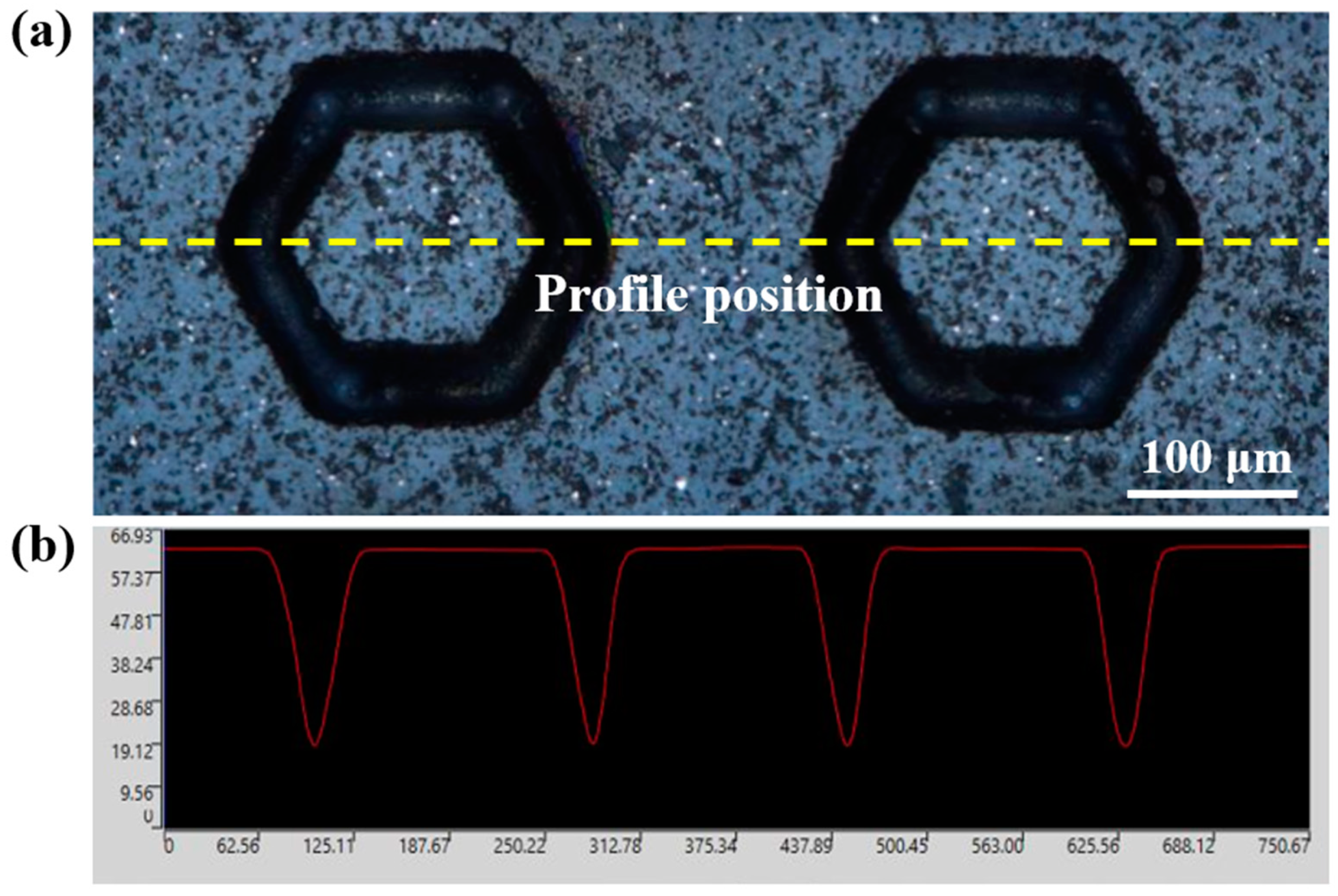

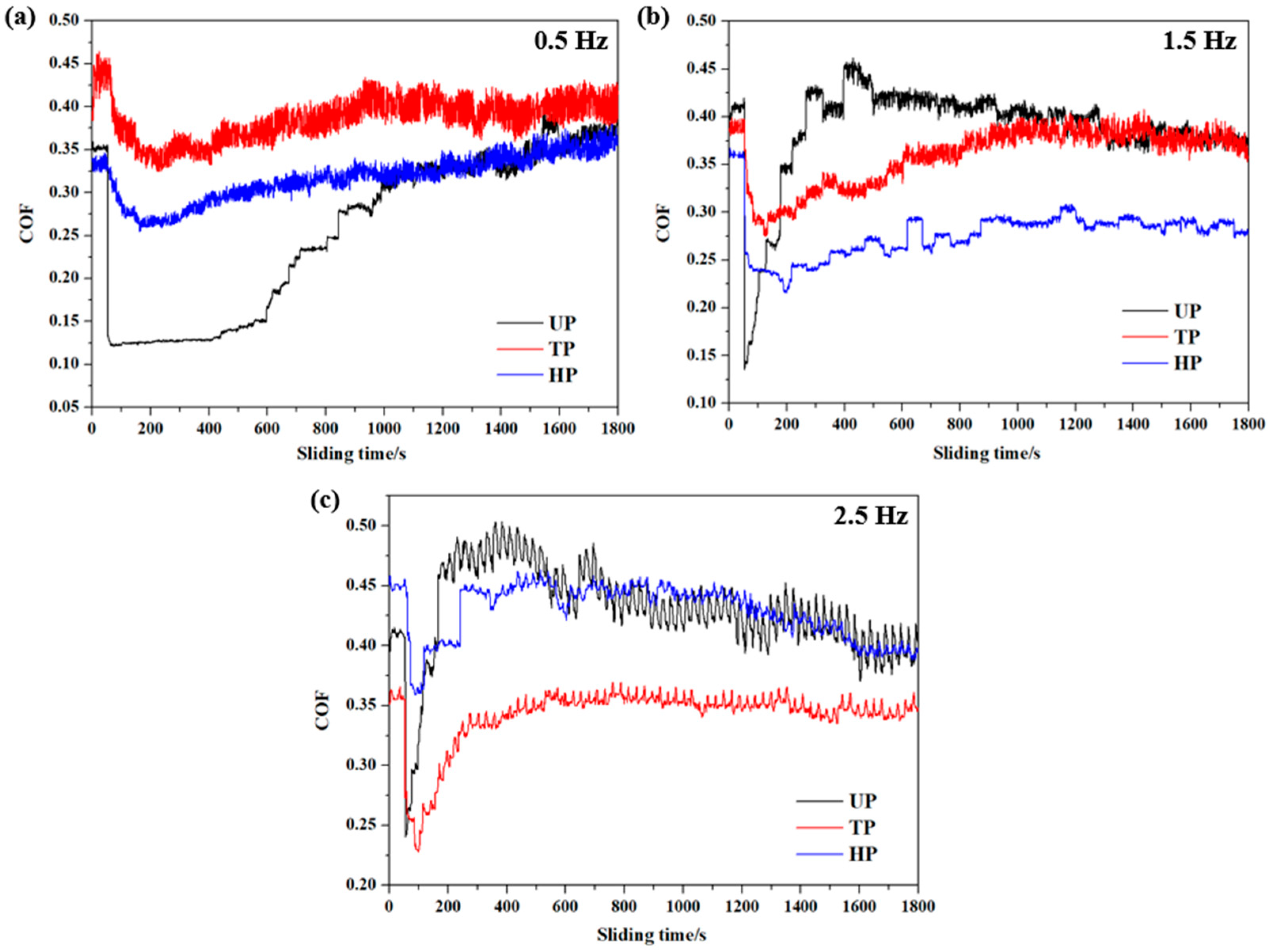
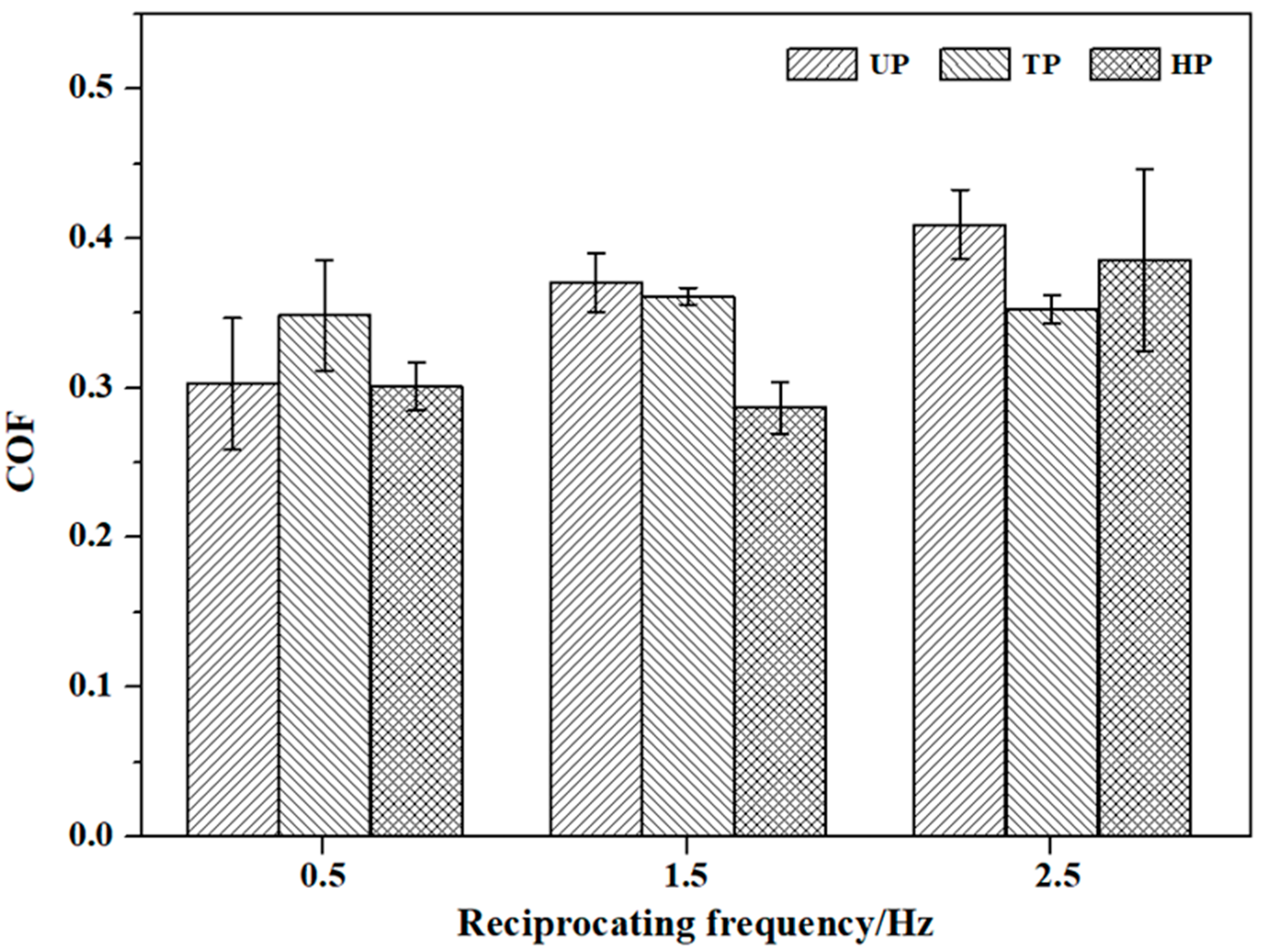
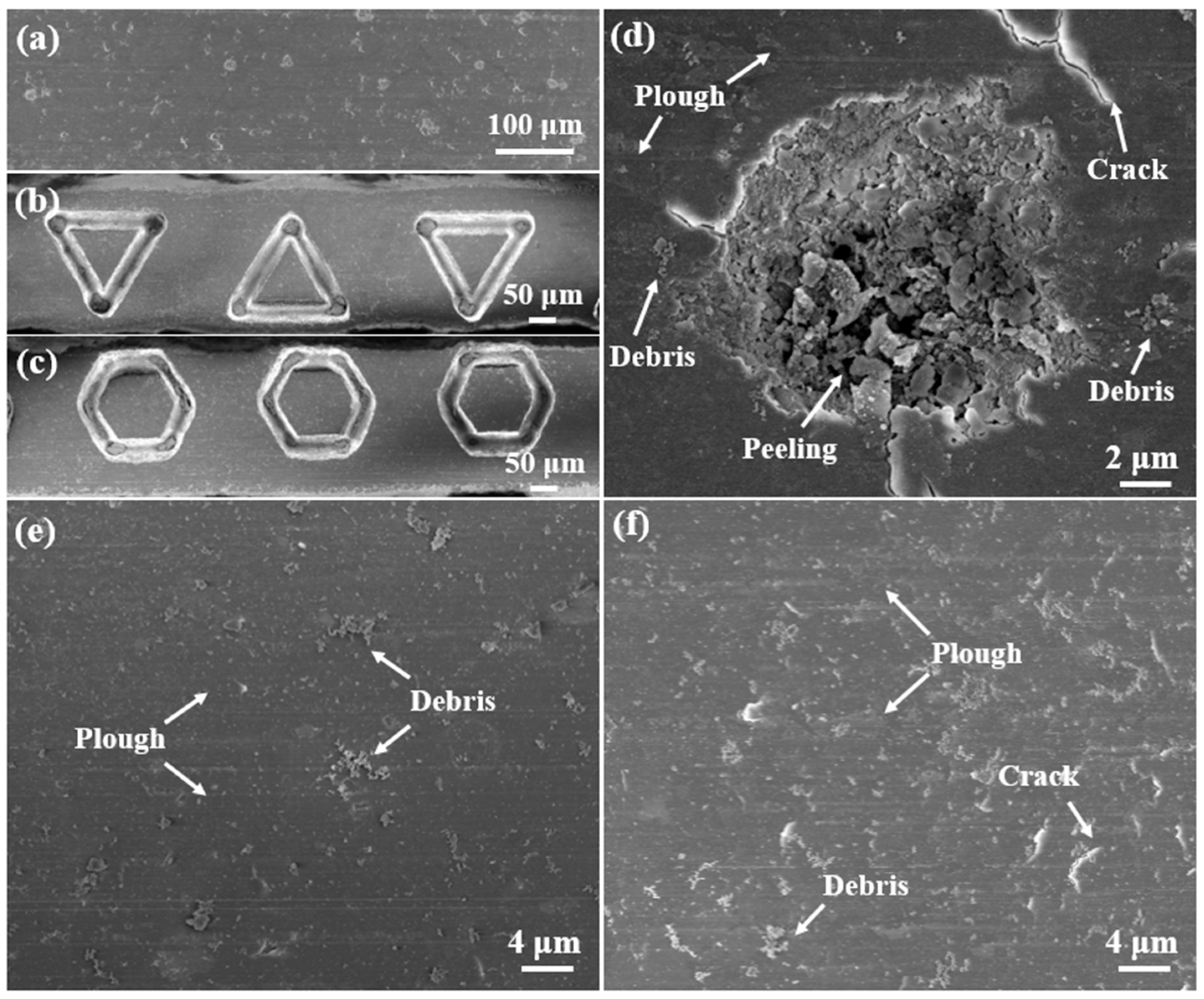


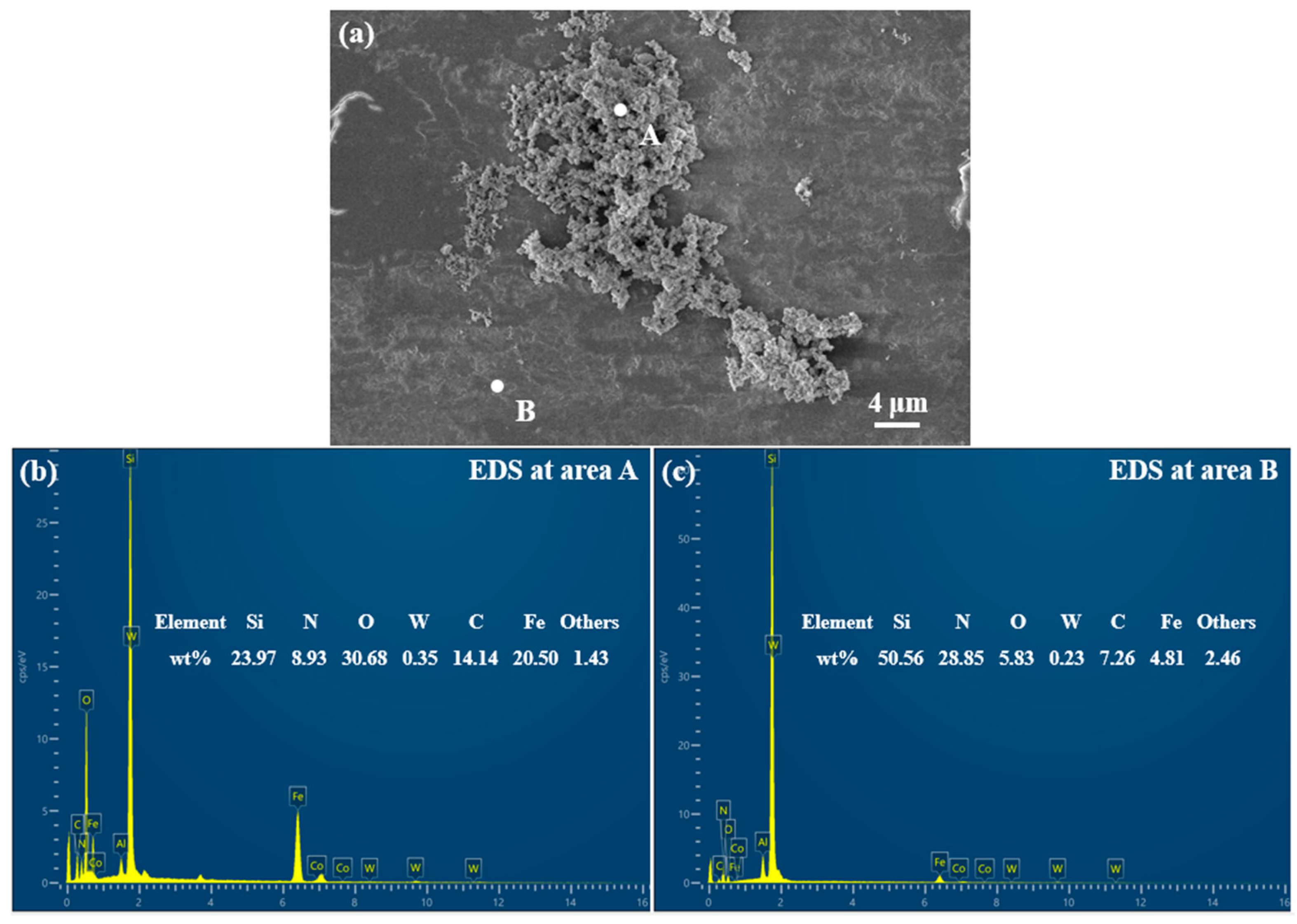

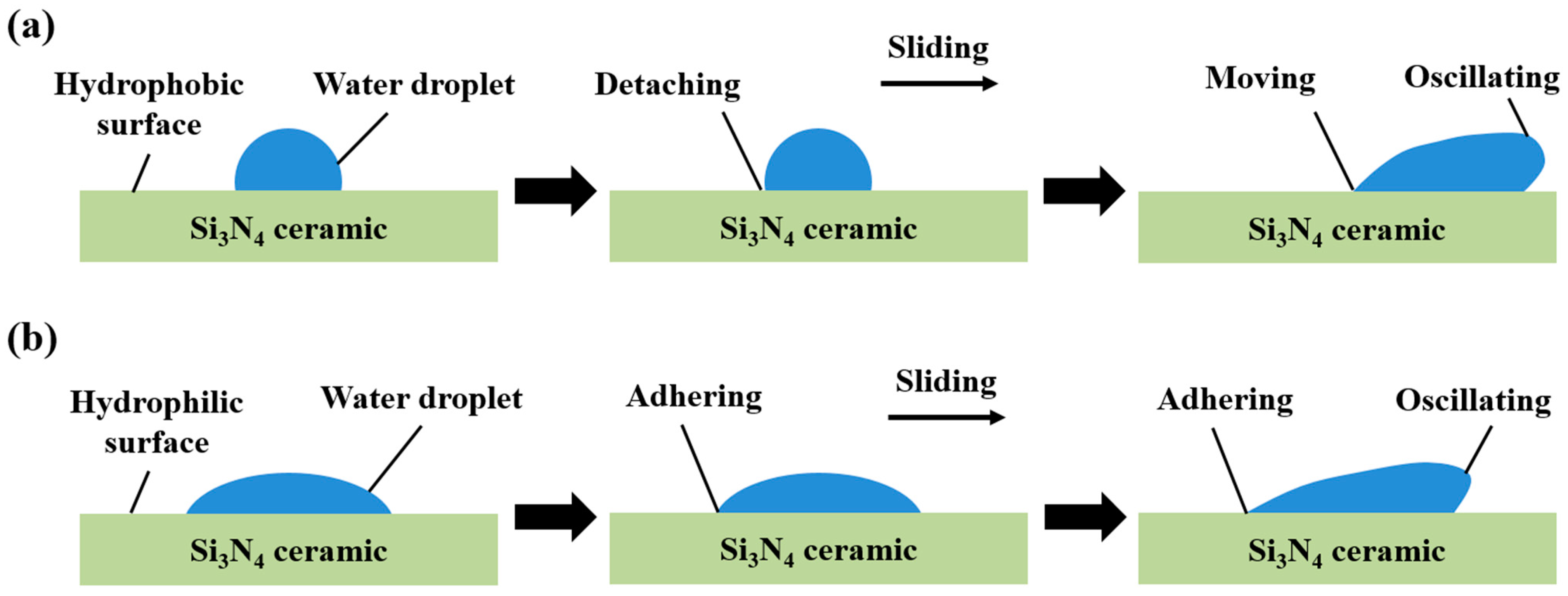
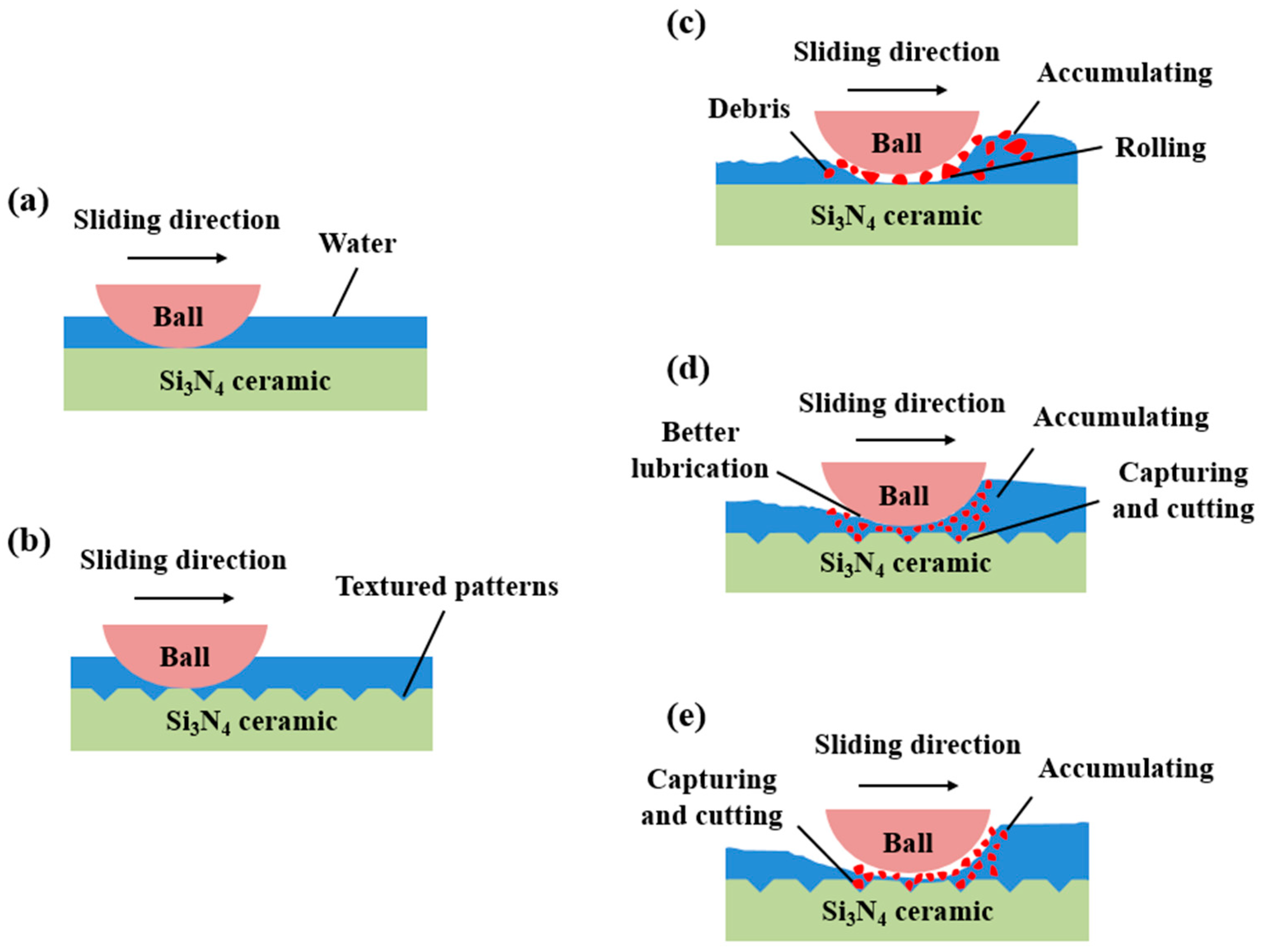
Disclaimer/Publisher’s Note: The statements, opinions and data contained in all publications are solely those of the individual author(s) and contributor(s) and not of MDPI and/or the editor(s). MDPI and/or the editor(s) disclaim responsibility for any injury to people or property resulting from any ideas, methods, instructions or products referred to in the content. |
© 2025 by the authors. Licensee MDPI, Basel, Switzerland. This article is an open access article distributed under the terms and conditions of the Creative Commons Attribution (CC BY) license (https://creativecommons.org/licenses/by/4.0/).
Share and Cite
Wang, H.-J.; Huang, J.-D.; Wang, B.; Zhang, Y.; Wang, J. Study on the Tribological Behavior of Laser Surface Texturing on Silicon Nitride Ceramic Under Water Lubrication. Lubricants 2025, 13, 21. https://doi.org/10.3390/lubricants13010021
Wang H-J, Huang J-D, Wang B, Zhang Y, Wang J. Study on the Tribological Behavior of Laser Surface Texturing on Silicon Nitride Ceramic Under Water Lubrication. Lubricants. 2025; 13(1):21. https://doi.org/10.3390/lubricants13010021
Chicago/Turabian StyleWang, Hong-Jian, Jing-De Huang, Bo Wang, Yang Zhang, and Jin Wang. 2025. "Study on the Tribological Behavior of Laser Surface Texturing on Silicon Nitride Ceramic Under Water Lubrication" Lubricants 13, no. 1: 21. https://doi.org/10.3390/lubricants13010021
APA StyleWang, H.-J., Huang, J.-D., Wang, B., Zhang, Y., & Wang, J. (2025). Study on the Tribological Behavior of Laser Surface Texturing on Silicon Nitride Ceramic Under Water Lubrication. Lubricants, 13(1), 21. https://doi.org/10.3390/lubricants13010021




